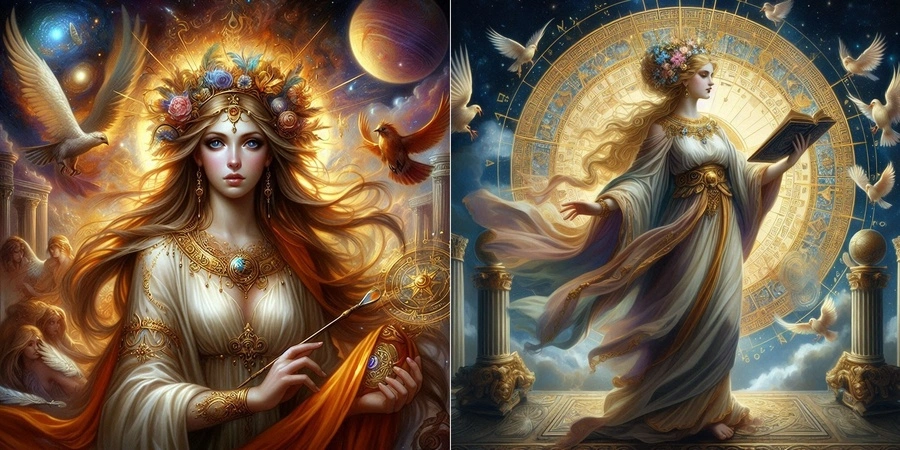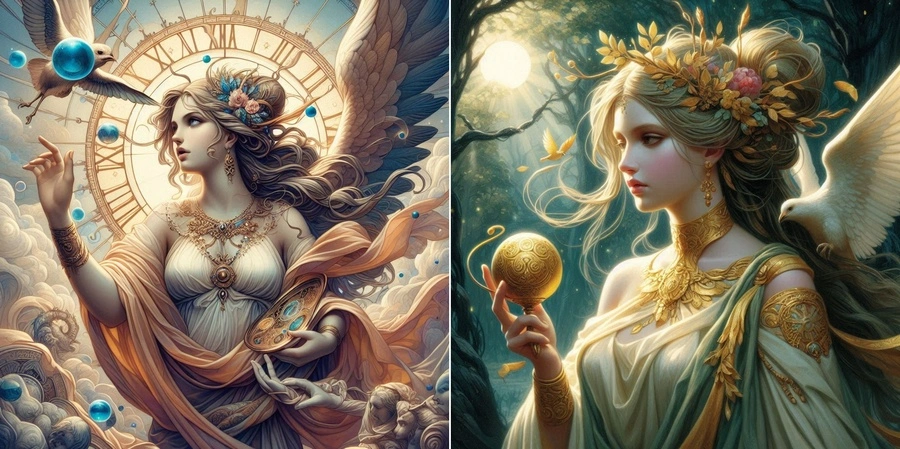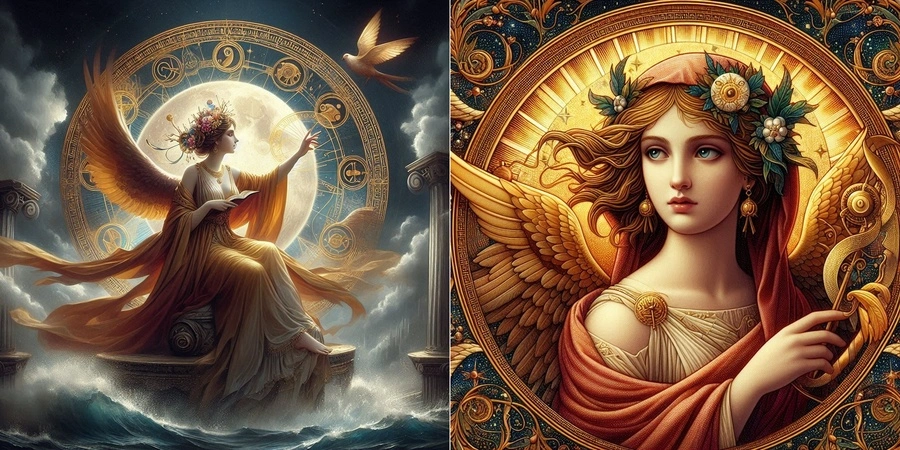
Phoebe was a Titaness in Greek mythology who was associated with prophecy and wisdom. She was one of the twelve Titans and played an important role in the mythology of the ancient Greeks.
This powerful lineage places her among the primordial deities who predate the Olympian gods. The Titans, representing various aspects of the natural and divine world, were considered the elder gods, whose reign preceded that of the more familiar Olympian pantheon led by Zeus.
The Story of Phoebe
Phoebe belonged to the primal generation of gods, the Titans. Born from the primordial union of Gaia (Earth) and Uranus (Sky), she embodied the essence of brilliance, as her name suggests (from the Greek word “phoibos” meaning “bright, shining”).
Phoebe’s significance lies not just in her lineage but also in her association with prophecy. According to some myths, she held the power of foresight and presided over the Oracle of Delphi, a sacred sanctuary known for pronouncements from the god Apollo. It is believed that Phoebe established the oracle and later bestowed it upon her grandson, Apollo, solidifying his association with prophecy and the epithet “Phoebus.”
As the wife of Coeus, another Titan, Phoebe became the mother of two significant figures. Leto, her first daughter, became pregnant with the twins Apollo and Artemis after Zeus’ jealous wife Hera relentlessly pursued her. Fleeing Hera’s wrath, Leto wandered the earth until finally finding refuge on the floating island of Delos, where she gave birth to the radiant twins. Phoebe’s second daughter, Asteria, transformed into the celestial body Asteria (sometimes referred to as “Astraea”) after being assaulted by Zeus. Asteria became the embodiment of falling stars, a celestial counterpoint to her sister Leto’s children, the sun and moon.

While later myths associated Phoebe with the moon, often conflating her with Selene, the moon goddess, her core essence extended beyond just lunar illumination. Phoebe’s brilliance was more metaphorical, representing intellectual light, wisdom, and the power of prophecy. She was a beacon guiding those who sought knowledge and understanding.
Unlike the prominent Olympian gods, Phoebe’s presence in myths diminished over time. The rise of Apollo and Artemis overshadowed her role, with Apollo inheriting the Delphic Oracle and becoming the primary deity of prophecy and light. Yet, Phoebe’s influence remained. She was the unseen force that paved the way for the ظهور (chūxiàn – emergence) of these prominent deities and the establishment of the oracle that held immense power in the ancient Greek world.
10 Myths and Facts About Phoebe in Greek Mythology
- Hidden Prophecy: While some myths depict Phoebe as the first Oracle of Delphi, others suggest a more subtle role. She might have possessed the power of foresight but never actively delivered prophecies. Instead, she may have imbued the location with its prophetic energy, paving the way for Apollo’s arrival.
- Goddess of Concealment: A lesser-known myth portrays Phoebe as a Titan associated not just with light but also with its absence. She might have been linked to shadows and the ability to veil things from sight, offering a more nuanced perspective on her brilliance – the ability to illuminate and obscure.
- Titan of Stars: Beyond her connection to the moon, some myths associate Phoebe with the twinkling tapestry of stars. She might have been envisioned as the one who kindled the celestial fire, igniting the first stars in the night sky.
- Lost Love and Transformation: A beautiful yet heartbreaking myth tells of Phoebe’s forbidden love with a mortal. Fearing Zeus’ wrath, she pleaded with Gaia for protection. The earth mother, touched by their love, transformed Phoebe into a radiant laurel tree, offering her a safe haven.
- Muse of Music and Poetry: While the Muses are typically associated with the Olympian gods, a lesser-known myth suggests Phoebe as the tenth Muse. Her brilliance could have manifested as an inspiration for the arts, particularly music and poetry, guiding creative expression.
- Pre-Olympian Power: The rise of the Olympian gods, led by Zeus, marked a shift in power. Phoebe, belonging to the older generation of Titans, may have seen her influence diminish as the Olympian pantheon established dominance.
- Connection to Artemis: Beyond Leto, some scholars posit a closer link between Phoebe and Artemis, the goddess of the hunt. Both were associated with celestial bodies (moon and stars), and their names might share an etymological root related to light.
- Epithets and Mystery: Like many Greek deities, Phoebe had various epithets or titles. “Phoebe Thea” (Phoebe the Divine) highlights her divinity, while “Koios” (Clever) hints at her intellectual brilliance. However, the exact meaning of some epithets remains open to interpretation.
- Artistic Depictions: Unlike the readily identifiable forms of Olympian gods, concrete artistic representations of Phoebe are scarce. Some speculate she might have been depicted as a radiant woman crowned with stars, but conclusive evidence is lacking.
- A Lasting Legacy: Though overshadowed by the rise of the Olympians, Phoebe’s influence persisted. The name of Saturn’s largest moon, Phoebe, serves as a lasting testament to the Titan who once held dominion over light and prophecy.

The Symbols of Phoebe
The Moon
One of the most prominent symbols associated with Phoebe is the moon. While later myths often conflate her with Selene, the goddess of the moon, Phoebe’s original connection to the moon signifies her association with celestial light and mystery. The moon, in its phases, represents the cycles of time and the hidden knowledge of the night, aligning with Phoebe’s role as a deity of prophecy and enlightenment. This connection to the moon also underscores her influence over night and darkness, realms traditionally associated with introspection and hidden wisdom.
The Radiant Crown
Phoebe is often depicted with a radiant crown, symbolizing her association with light and celestial phenomena. This crown is not merely a decorative element but a representation of her divine authority and her role as a bearer of celestial light. The radiant crown signifies enlightenment, clarity, and the divine right to guide and illuminate the paths of others, particularly in the realm of prophecy.
Laurel Wreath
Another symbol tied to Phoebe is the laurel wreath, which is often associated with her grandson Apollo. The laurel wreath represents victory, wisdom, and eternal life. In the context of Phoebe, the laurel wreath emphasizes her connection to prophetic insight and her role in the tradition of oracles. It signifies the enduring nature of her wisdom and the triumph of divine knowledge over ignorance.
The Oracle of Delphi
The Oracle of Delphi itself stands as a symbolic representation of Phoebe’s influence. Though primarily associated with Apollo, the oracle’s establishment and its function as a center of prophetic wisdom trace back to Phoebe. The physical space of the oracle, located at the sanctuary of Delphi, symbolizes a portal between the divine and mortal worlds, where Phoebe’s legacy in prophecy is perpetuated. The oracle represents the divine gift of foresight and the communication between gods and humans.
The Dove
The dove is another symbol linked to Phoebe, representing peace, purity, and prophetic insight. In Greek mythology, birds were often seen as messengers of the gods, and the dove, in particular, was considered a bearer of divine messages. Phoebe’s association with the dove highlights her role as a communicator of divine will and her purity as a goddess of wisdom and light.
The Torch
Phoebe is sometimes depicted holding a torch, symbolizing enlightenment and the dispelling of darkness. The torch is a powerful emblem of knowledge and the illuminating power of divine wisdom. In this context, Phoebe’s torch signifies her role in guiding the way through the darkness of ignorance and uncertainty, providing clarity and understanding through prophetic insight.
The Star
Stars are also significant symbols associated with Phoebe. Stars represent guidance, celestial navigation, and the eternal nature of the cosmos. Phoebe’s connection to stars emphasizes her role in the celestial order and her ability to navigate and harmonize the divine realms. The star symbolizes her enduring presence in the heavens and her role as a guide and illuminator.
The Sacred Grove
Phoebe is often associated with a sacred grove, a symbol of divine wisdom and hidden knowledge. Sacred groves in Greek mythology were places of worship and contemplation, where mortals could connect with the divine. Phoebe’s grove represents a sanctuary of enlightenment and the hidden mysteries of the cosmos. It is a place where the natural and the divine intersect, embodying the sacredness of nature and the wisdom it holds.
The Owl
The owl, a symbol of wisdom and insight, is another emblem connected to Phoebe. The owl’s keen vision in the dark parallels Phoebe’s prophetic abilities and her association with the night and the moon. As a bird of wisdom, the owl represents Phoebe’s intellectual prowess and her role as a guardian of divine knowledge.
The Serpent
In some depictions, the serpent is a symbol associated with Phoebe. The serpent, often seen as a creature of transformation and rebirth, signifies the cyclical nature of life and the hidden knowledge of the earth. For Phoebe, the serpent represents her connection to the chthonic elements of prophecy and the deep, transformative power of wisdom.

The Powers of Phoebe in Greek Mythology
- Prophetic Powers: One of Phoebe’s most notable powers is her prophetic ability. As a Titaness closely associated with the Oracle of Delphi, she embodies the divine gift of foresight. This oracle was one of the most revered prophetic sites in ancient Greece, where mortals sought guidance from the gods. Phoebe’s connection to this sacred place underscores her role in the tradition of prophecy. Before Apollo took over the oracle, it is believed that Phoebe held this position, symbolizing her deep-seated wisdom and the transmission of prophetic powers within her lineage.
- Celestial Light and Luminescence: Phoebe’s name, often associated with brightness and radiance, highlights her connection to celestial light. This luminescent quality is not only symbolic but also indicative of her divine powers. Her association with the moon and celestial bodies positions her as a beacon of light in the mythological cosmos. This light is both literal and metaphorical, representing clarity, purity, and the dispelling of darkness.
- Wisdom and Intellectual Insight: Wisdom is another significant power attributed to Phoebe. Her intellectual prowess and deep understanding of the cosmos make her a guardian of divine knowledge. This wisdom is not just intellectual but also deeply spiritual, encompassing the mysteries of the universe and the hidden truths of existence. Phoebe’s wisdom is reflected in her descendants, particularly Apollo and Artemis, who inherit and perpetuate her intellectual and prophetic legacy.
- Influence over Celestial Navigation: Phoebe’s powers extend to celestial navigation, an essential aspect of ancient Greek cosmology. As a Titaness associated with the stars and the heavens, she plays a crucial role in guiding the movements of celestial bodies. This ability to navigate and harmonize the stars underscores her importance in maintaining the cosmic order. Her influence over celestial navigation also symbolizes her role in guiding the divine journeys of gods and mortals, ensuring that they follow the right paths.
- Guardian of Sacred Groves: Phoebe’s power is also evident in her guardianship of sacred groves. These groves, often seen as places of divine presence and worship, represent the intersection of the natural and the supernatural. As a guardian of these sacred spaces, Phoebe embodies the sanctity and purity of nature, protecting the hidden wisdom and spiritual energy contained within them. This guardianship underscores her role as a custodian of divine knowledge and the natural world.
- Ancestral Power: As a matriarch in the mythological hierarchy, Phoebe’s power is reflected in her descendants. Her children, Leto and Asteria, and her grandchildren, Apollo and Artemis, carry forward her divine attributes. This ancestral power highlights the transmission of divine qualities through generations, ensuring that Phoebe’s influence remains integral to the mythological narrative. Her descendants embody her prophetic, intellectual, and luminescent powers, perpetuating her legacy within the pantheon.
Phoebe’s prophetic abilities are not merely limited to the Oracle of Delphi. Her overall persona exudes an aura of foresight and enlightenment, qualities that are vital in the pantheon. These abilities allowed her to perceive the future and provide guidance, making her an essential figure for those seeking insight into their destinies.
The power of celestial light ties Phoebe to the cycles of the moon and the stars, which were critical in ancient Greek religion and daily life. This connection to the lunar cycles emphasizes her influence over time and natural rhythms, aligning her with the divine order of the universe. Her luminescent power also serves as a source of guidance and inspiration, illuminating the paths of gods and mortals alike.
This profound wisdom positions Phoebe as a mentor and guide within the mythological framework. Her insights are sought by other deities and mortals, reinforcing her role as a divine counselor. This intellectual power is also evident in her ability to maintain balance and harmony within the cosmos, ensuring the proper functioning of celestial and earthly realms.